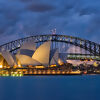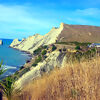33 Nights | FJORDS TO ATOLLS
You will visit the following 4 places:

Tahiti
Tahiti is the largest island in French Polynesia, the South Pacific archipelago. This overseas collectivity of the French Republic is sometimes referred to as an overseas country. The island was formed from volcanic activity and is high and mountainous with surrounding coral reefs. Tahiti was originally settled by Polynesians between 300 and 800 CE. They represent about 70% of the island's population with the rest made up of Europeans, Chinese and those of mixed heritage. The island was part of the Kingdom of Tahiti until its annexation by France in 1880, when it was proclaimed a colony of France. It was not until 1946 that the indigenous Tahitians were legally authorised to be French citizens. French is the only official language although the Tahitian language (Reo Tahiti) is widely spoken.

Sydney
Sydney is the largest and most populous city in Australia and the state capital of New South Wales. The city is located on Australia's south-east coast of the Tasman Sea. It is also the oldest and most cosmopolitan city in Australia with an enviable reputation as one of the world's most beautiful and liveable cities. Brimming with history, nature, culture, art, fashion, cuisine, design, Sydney's set next to miles of ocean coastline and sandy surf beaches. Long-term immigration has led to the cities reputation as one of the most culturally and ethnically diverse cities in Australia and the world. The city is also home to the Sydney Opera House and the Sydney Harbour Bridge, two of the most iconic structures on this planet.

Dunedin
Dunedin is the second-largest city in the South Island of New Zealand, and the principal city of the Otago Region. It is considered to be one of the four main urban centres of New Zealand for historic, cultural, and geographic reasons. Dunedin was the largest city by territorial land area until superseded by Auckland on the creation of the Auckland Council in November 2010. Dunedin was the largest city in New Zealand by population until about 1900. The Dunedin urban area lies on the central-eastern coast of Otago, surrounding the head of Otago Harbour. The harbour and hills around Dunedin are the remnants of an extinct volcano. The city suburbs extend out into the surrounding valleys and hills, onto the isthmus of the Otago Peninsula, and along the shores of the Otago Harbour and the Pacific Ocean.

Napier
Napier is a New Zealand city with a seaport, located in Hawke's Bay on the eastern coast of the North Island. About 18 kilometres south of Napier is the inland city of Hastings. These two neighbouring cities are often called "The Bay Cities" or "The Twin Cities" of New Zealand. Napier is a popular tourist city, with a unique concentration of 1930s Art Deco architecture, built after much of the city was razed in the 1931 Hawke's Bay earthquake. It also has one of the most photographed tourist attractions in the country, a statue on Marine Parade called Pania of the Reef. Thousands of people flock to Napier every February for the Tremains Art Deco Weekend event, a celebration of its Art Deco heritage and history. Other notable tourist events attracting many outsiders to the region annually include F.A.W.C! Food and Wine Classic events, and the Mission Estate Concert at Mission Estate and Winery in the suburb of Taradale.









